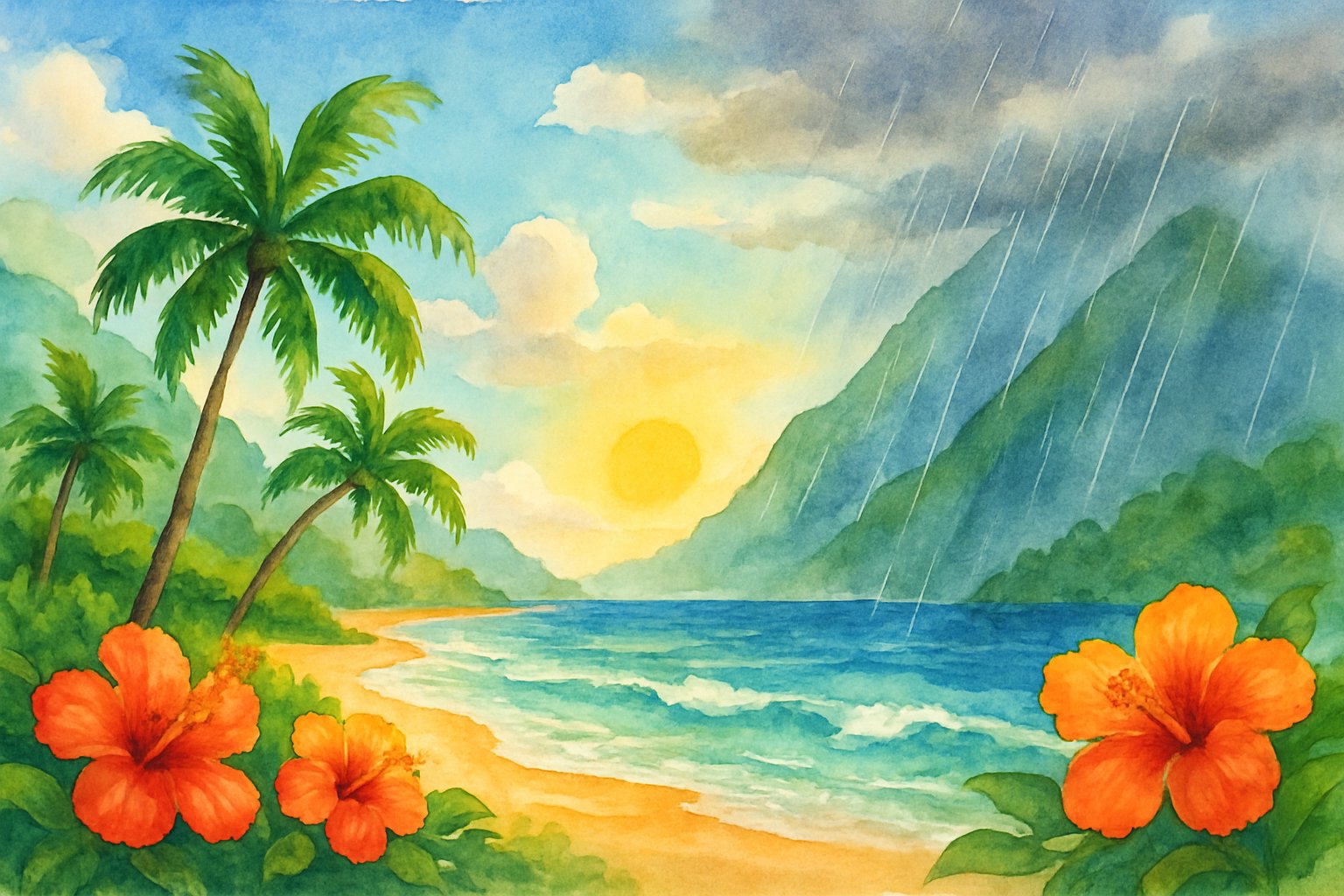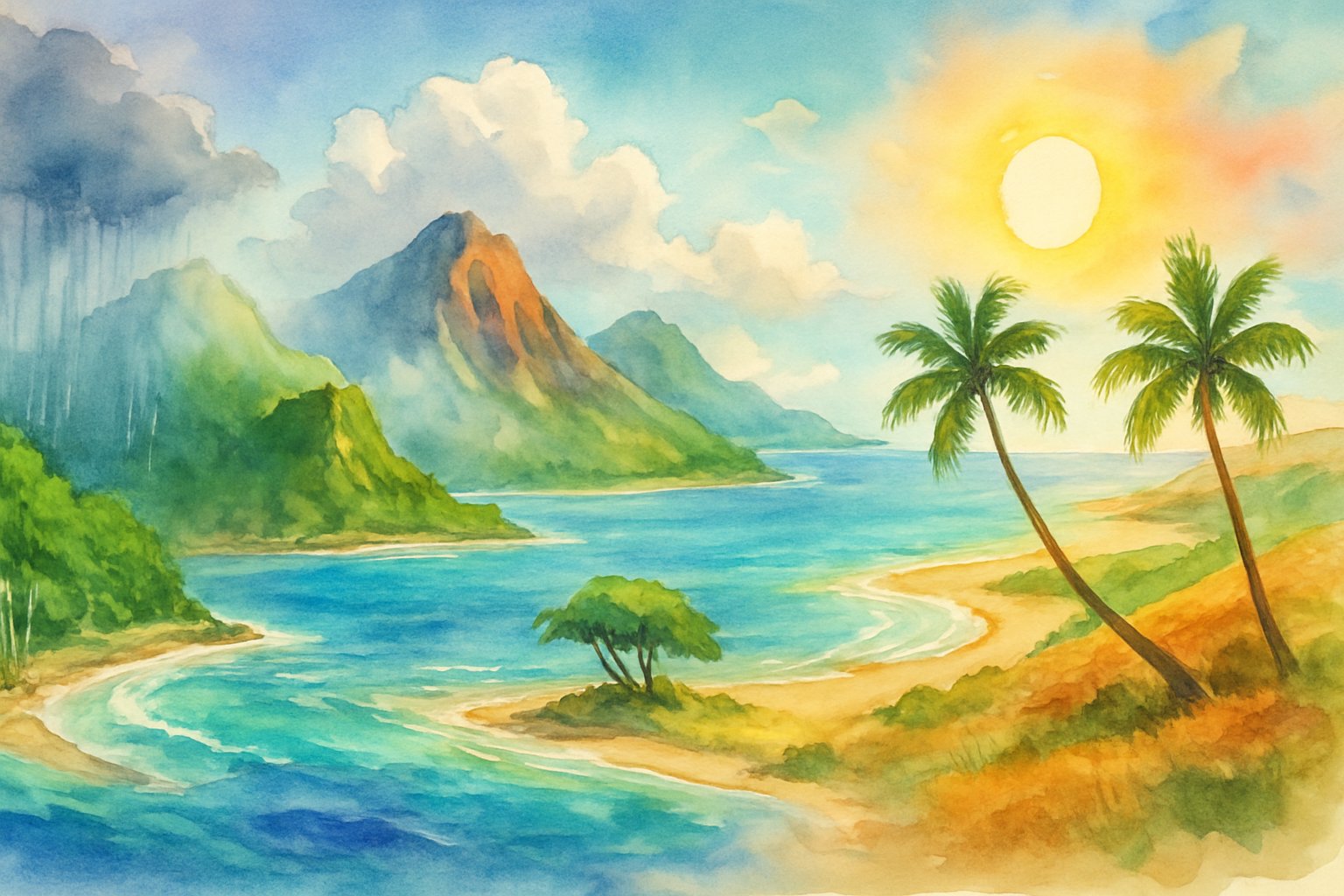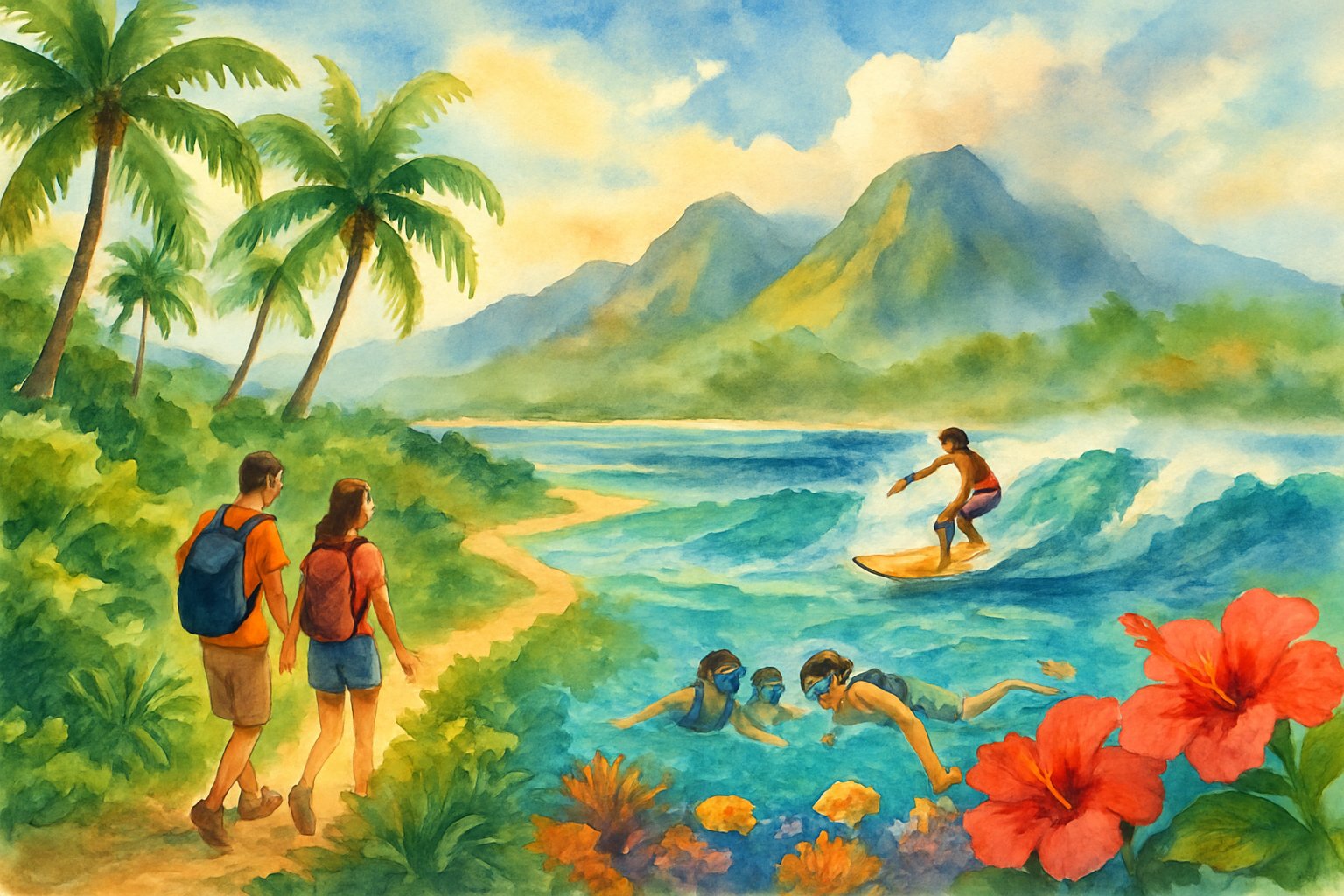When I think of a tropical paradise, Hawaii is the first place that comes to my mind. Its warm breezes, sunny skies, and steady temperatures attract visitors all year.

Hawaii’s weather stays mild and pleasant year-round. Average temperatures at sea level usually range from the mid-70s to the mid-80s Fahrenheit, as shown on this weather in Hawaii page.

Rainfall changes by season, but Hawaii still gets plenty of sunshine for the beach or exploring the islands. Winter months often bring more showers, especially from October to April, while May to September is usually drier, according to the climate of Hawaii guide.
If you know what to expect from Hawaii’s climate, you can plan your trip and pack the right clothes. Whether I’m relaxing on the sand or hiking a lush trail, understanding the weather helps me make the most of my time in paradise.
Hawaii’s Unique Climate Overview
Hawaii’s climate feels different from most places in the US. Because the Hawaiian Islands sit in the tropics, I notice warm temperatures and gentle breezes almost every day.
Understanding Hawaii’s Tropical Climate
Hawaii has a tropical climate, so it stays warm and mild all year. I rarely see extreme temperatures here.
The yearly average temperature only shifts a few degrees between summer and winter. Most days, the thermometer shows 78 to 85°F along the coasts.
Humidity levels are moderate and not uncomfortable. It rains enough to keep the scenery green, especially in mountain areas, but the southern coasts are much drier than the northern or eastern sides.
Oceanside locations are usually sunnier. Each island has its own microclimates, so I might find rain in one spot and sunshine in another just a few miles away.
The unique landscape of the Hawaiian Islands creates these local differences. For more details, the National Weather Service summarizes Hawaii’s climate.
Year-Round Weather Patterns in Hawaii
Hawaii mainly has two seasons: summer (kau) from May to October and winter (hoʻoilo) from November to April. Temperatures shift only a little between seasons, so both times of year stay pleasant.
In the summer, days are slightly warmer and drier. Winters are a bit cooler and wetter, especially on the windward (eastern and northern) sides of the islands.
Snow falls only on the very tops of Hawaii’s highest volcanoes like Mauna Kea, which is rare for a tropical place. The southern coasts often have the driest weather all year long, making them great spots for outdoor activities.
To see more about the seasonal patterns, I find the Go Hawaii weather guide helpful.
Influence of Trade Winds and Wind Patterns
Northeasterly trade winds sweep across Hawaii almost every day. These steady winds keep temperatures from getting too hot and help keep humidity at comfortable levels.
Trade winds bring light showers, mostly to the windward sides, which explains why these areas are so lush. When the winds weaken, I sometimes feel the weather get muggy or notice short spells of hotter temperatures.
Kona winds (from the southwest) occasionally bring less predictable weather, like sudden rain or higher humidity. The trade winds help make living in Hawaii pleasant with fresh air and gentle breezes all year.
A good breakdown of wind influences is on the Hawaii National Weather Service.
Seasons in Hawaii: What to Expect

Hawaii only has two main seasons, summer and winter, but the differences are mild. Each brings unique weather patterns, temperatures, and rainfall, so it helps to know what to expect when I plan a trip.
Summer Months: Weather and Temperatures
The summer months in Hawaii, called “kau,” run from May through October. During this time, the weather is warmer and a bit drier.
I usually see average high temperatures around 85°F (29°C) in the afternoon. Nights are mild, with temperatures dropping to about 71°F (22°C).
Rainfall is lower in the summer, so I can expect more sunny days, especially if I visit coastal areas. Humidity is present but not overwhelming, and the trade winds help cool things down.
Ocean conditions are usually calm, making it a great time for swimming and snorkeling. Here’s a quick look at average summer temperatures:
| Month | High (°F) | Low (°F) |
|---|---|---|
| May-Oct | 85 | 71 |
If I like outdoor activities, hiking and beach visits are comfortable during these months.
Winter Months: Climate and Conditions
Hawaii’s winter, or “hoʻoilo,” lasts from November through April. This season brings cooler temperatures, with daytime highs averaging 79–83°F (26–28°C).
Nights feel a little cooler, but it rarely drops below 65°F (18°C). Winter is when I can expect more rain, especially in the northern and windward parts of each island.
Rain usually comes in short showers, so sunny weather is still common. The mountains and valleys see the most rain.
Winter on the islands is also surf season. The north shores of Oahu and other islands get large waves, which is exciting for watching surfers.
If I want calmer seas, the south shores are better in winter.
Rainfall, Humidity, and Moisture
Hawaii has distinct patterns of rainfall and humidity that can change from one place to another, even on the same island. Different months bring wetter or drier weather, while local winds and geography shape how humid or moist it feels each day.
Annual Rainfall and Seasonal Moisture
Across Hawaii, rainfall changes a lot depending on the area. The windward sides get much more rain than the leeward sides.
Some places like Hilo on the Big Island are very wet, with over 120 inches of rain each year, while spots like Waikiki get less than 30 inches.
High-altitude slopes receive frequent showers and thick clouds, making them some of the wettest parts of the islands. Down closer to sea level, especially on the leeward coasts, it can be quite dry for long stretches.
Most of Hawaii’s rainfall comes during the late fall and winter. The wettest months are generally from November to March.
Even in these months, heavy rain often stays in certain areas, so it’s possible to find sun nearby even when it’s raining just a few miles away. (For more local details see Hawaii rainfall patterns.)
Humidity Levels and Relative Humidity
Humidity in Hawaii is usually moderate, often between 60% and 80% throughout the year. Most days, the air feels moist and comfortable, but it can feel sticky when the winds slow down or in areas with thick vegetation.
Trade winds help lower the “sticky” feeling by moving the air and carrying moisture away. When these winds drop, especially during the summer, humidity can rise and things start to feel warmer and muggy.
Relative humidity stays steady because of the ocean air. Coastal areas can feel muggy in the mornings but usually become more comfortable by afternoon.
On higher mountains, the air can feel fresher and less humid, making those areas a good place to cool down.
Rainy Season vs. Dry Season
Hawaii’s rainy season happens from November to March. During this time, I expect more rain, especially on the windward sides of the islands and in the mountains.
Heavy showers can move in fast, but often they don’t last long. Vacation plans are rarely ruined by these quick bursts because they pass quickly and are often most common at night or early in the morning.
Learn more about the rainy season in Hawaii.
The dry season stretches from April to October. During these months, rainfall drops, and days are usually sunny and bright, especially along the coasts.
This is the best time for outdoor activities like swimming or hiking if I want to avoid surprise showers. Some areas, such as the leeward coasts of Oahu, Maui, and the Big Island, may go weeks without any rain at all.
Climate Variations Across the Hawaiian Islands

Each Hawaiian island has its own weather patterns, shaped by mountains, valleys, and the ocean. Local geography can change temperatures, rainfall, and humidity over short distances.
Oahu and Honolulu: Urban Climate
On Oahu, the weather is warm and pleasant throughout the year. In Honolulu, the city heat and sea breezes mix to make summer days feel slightly warmer compared to other areas.
Most rain falls during the winter months, but showers are usually quick. Downtown, the tall buildings and busy roads trap more heat at street level.
This “urban heat island” effect makes it a bit hotter in the city than in nearby areas. Because Oahu has both mountains and coastal plains, weather can be different just a short drive away.
The windward east side is wetter than the dry leeward west side.
Key points for Oahu:
- Year-round highs: 78°F–88°F
- Humidity is usually moderate
- Rain showers are brief and scattered
Big Island: Mauna Kea, Mauna Loa, and Hamakua Coast
The Big Island has huge climate contrasts because of its large mountains—Mauna Kea and Mauna Loa. These peaks rise over 13,000 feet, so I can go from warm beaches to chilly mountaintops in a single adventure.
On the Hamakua Coast, trade winds bring steady rain, especially in the winter. The eastern side is lush and green, while the western side gets much less rain.
If I drive up Mauna Kea or Mauna Loa, the air gets noticeably cooler, and even snow falls at the summit during the colder months. Volcanic landscapes mean I might see everything from tropical forest to barren lava fields in just a few miles.
It’s common to experience dry, sunny weather in Kona and heavy rain in Hilo on the same day.
| Location | Average High Temp (°F) | Notable Features |
|---|---|---|
| Hamakua Coast | 75–82 | Frequent rainfall |
| Mauna Kea Summit | 32–50 | Can see snow in winter |
| Kona Coast | 80–87 | Sunny, drier conditions |
Exploring Maui’s Microclimates
Maui features many microclimates on a small island.
The west side, like Lahaina and Kaanapali, stays warm and dry most of the year. This makes it great for the beach.
The slopes of Haleakala volcano feel much cooler. Clouds often gather there in the afternoon.
Upcountry areas, such as Kula, are cooler and breezier than the coasts.
Eastern Maui, especially Hana, gets heavy rainfall. This keeps its rainforests green and full of waterfalls.
I can drive from sunshine into rain within an hour.
Northeast winds bring most of the moisture to the island. The mountains create a rain shadow, so the south and west sides stay much sunnier.
Quick facts about Maui’s microclimates:
- West and south: dry, sunny, 80–90°F
- Upcountry: cooler, 60–75°F
- East/Maui Hana: rainy, lush forests
Waimea, Kona, and Diverse Topography
Waimea sits between the wet Hamakua Coast and the dry, sunny Kona Coast on the Big Island.
Because Waimea is higher up in the hills, it feels cooler and windier. Mornings in Waimea often start misty and gray. Skies usually clear up by midday.
Kona, down by the sea, is known for warm, dry weather and clear skies. The area is perfect for beaches and coffee farms.
The elevation changes here are dramatic. I can go from sea level in Kona to over 3,000 feet in Waimea, and each area has a distinct climate.
Rolling hills, tall volcanoes, and deep valleys shape the region. Each area feels a little different, even though they are close together.
Highlights for Waimea & Kona:
- Waimea: cool, breezy, frequent mist
- Kona: hot, dry, lots of sunshine
- Quick elevation changes create sharp climate shifts
Elevation’s Impact on Weather
Elevation changes the climate in Hawaii.
Temperature at sea level is very different from the chilly peaks. Some mountains are cold enough for snow.
Temperature Changes With Elevation
When I travel from the beach to higher ground, I notice the air cooling quickly.
For every 1,000 feet I climb, the temperature drops by about 3 to 3.5°F. A spot near sea level may feel warm and sunny. In the hills or mountains, it’s often much cooler.
When I walk up the slopes of Mauna Kea or Mauna Loa, I need more layers than at sea level. At low elevations, the average temperature rarely falls below 65°F.
Higher areas can feel chilly even during the day. Evenings are especially cool.
Here’s a quick breakdown:
| Elevation | Typical Temperature |
|---|---|
| Sea Level | 75–85°F (24–29°C) |
| 5,000 feet | 57–67°F (14–19°C) |
| 13,000 feet+ | 32–45°F (0–7°C) |
Knowing this helps me pack and dress right, whether I’m hiking or driving up the mountain.
Temperatures decrease with elevation.
Snowfall on Hawaii’s Peaks
Many people are surprised to learn it can snow in Hawaii.
Snow falls only at the tallest volcanoes, like Mauna Kea and Mauna Loa, which rise over 13,000 feet above sea level.
During winter, storms can bring several inches or even feet of snow to the summits. Even though the beaches stay warm, I can see snow from a distance on clear days.
The sun melts the snow quickly once the weather clears up.
Mauna Kea is famous for its snowy cap. Scientists and visitors often travel there to see it.
Sometimes, locals snowboard or build snowmen up there. This feels surreal in a tropical place.
For more about these changes, I check out guides on big island weather.
Climate Phenomena Affecting Hawaii
Global and local climate patterns shape Hawaii’s weather.
Seasonal changes often depend on shifts in Pacific Ocean temperatures and where rain falls on the islands.
The Role of El Niño and Weather Systems
El Niño happens when the Pacific Ocean is warmer than usual along the equator.
When El Niño hits, the weather gets drier than normal, especially during winter. Trade winds slow down, making the air feel warmer and stuffy.
Storms can bring heavy rain, but strong El Niño years can also cause more droughts and brush fires.
Weather systems from the north Pacific, like high-pressure zones, also affect daily conditions. These high-pressure areas send cool trade winds, keeping the islands comfortable most of the year.
When high-pressure systems weaken, temperatures rise and humidity increases.
Sometimes, hurricanes or tropical storms bring sudden heavy rain and high winds. While these events are rare, I pay close attention to weather alerts during hurricane season.
For more details on how these patterns affect our weather, I check the Hawaiʻi government climate site.
Tropical Rainforest Zones in Hawaii
Hawaii has some of the wettest spots in the world.
Areas like Hilo and parts of Kauai get dense rainfall because they sit on the windward side of tall volcanoes. These rainforest zones have steady rain, helping thick forests and green growth thrive.
When I visit these places, I see lush valleys and waterfalls.
Average yearly rainfall in a tropical rainforest area like Mākaha Valley can reach several hundred inches.
Warm temperatures stay nearly the same throughout the year. Mist and clouds are common.
Heavy rain shapes the land by causing runoff and filling streams. Sometimes, it creates flash floods.
If you travel here, be ready for mud and slippery trails. Packing rain gear is always a good idea.
For more about rainfall and climate zones, I use this Hawaii climate guide.
Tips for Travelers and Outdoor Activities

When I visit Hawaii, I pay attention to the seasons and weather changes.
This helps me plan my activities and stay comfortable, whether I’m hiking, sightseeing, or enjoying festivals.
Travel Planning Based on Weather
I always check the weather before I choose my travel dates.
Hawaii’s climate stays mild year-round, but there are differences between seasons. Summer, from May to October, is warmer and usually sunnier, with daytime highs between 85–90°F (29–32°C).
Winter temperatures are a bit cooler, averaging around 78°F (25.6°C), and it can be rainier.
I like to travel during April–May or September–November because the weather is pleasant and there are fewer crowds.
If I plan to spend time outdoors, I pack lightweight clothes, sunscreen, and a hat for sun protection.
During the rainy season, I keep a light rain jacket in my bag in case of sudden showers.
Checking local weather forecasts before leaving helps me adjust my plans if needed.
You can find more about Hawaii temperatures and best travel times here.
Exploring and Hiking in Changing Weather
When I go hiking or exploring on the islands, I prepare for changing weather.
In the mornings, the trails feel cooler and less crowded, which I enjoy.
Since weather can shift quickly, especially in the mountains, I pack a small backpack with water, bug spray, snacks, a rain jacket, and an extra layer.
I stay on marked trails because sudden rain can make conditions slippery or unsafe.
Before I head out, I always let someone know where I’ll be.
I check local trail conditions online or at visitor centers to avoid hiking in bad weather.
If I am interested in art, I look for outdoor art fairs or local galleries that may have special events when the weather is clear.
Planning ahead helps me enjoy my outdoor adventures more.
Get more tips for exploring Hawaii’s weather and outdoor safety.




